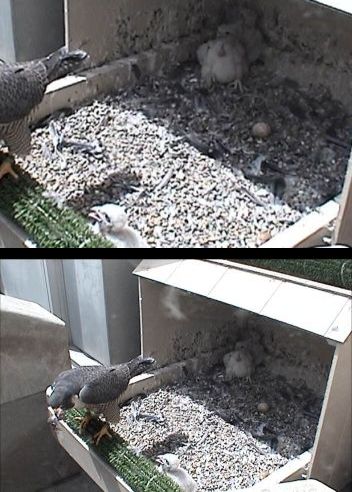 In the next day or two the setting on the falconcam at the University of Pittsburgh will move out for a wider view of the nest. It won’t be a major change but those of you who watch daily will see a difference.
In the next day or two the setting on the falconcam at the University of Pittsburgh will move out for a wider view of the nest. It won’t be a major change but those of you who watch daily will see a difference.
Why zoom out?
For the past eight weeks the action at the nest has been focused on one tiny area – the scrape where the eggs were laid – because the chicks weren’t very mobile.
But now at fifteen days old (that’s today) they’ve begun to move around the nest platform. They’re discovering their feet and wings and will soon figure out they can pursue their parents if food doesn’t reach them fast enough. The camera will pull back so we don’t miss the action.
To give you an idea of how it will look here’s a comparison using a snapshot from last year when the camera was set at the wider angle. I cropped the photo to match the zoomed-in view and placed that above. The bottom one is wide angle.
Notice what the zoomed-in view misses. There’s a chick with his beak open at the front of the box near the green perch. Why is he begging? In the top picture all we can see is his parent’s tail. In the wider view we know he’s begging because Mom is holding food in her beak. Click on the picture for a second example when the chicks are about to fledge. Notice the cute expression you’d never see if the camera was zoomed in!
There’s one more thing to know about the camera. During the nesting season its weatherproof cover gets dirty. Sometimes prey feathers stick to it, sometimes the sun glints off the rain spots, sometimes the sun reflects inside the cover and makes it hard to see. This is just a normal side effect of watching wildlife through a remote camera. We can’t clean the camera while they’re nesting so we’ll just have to bear with it. The good news is that it can be cleaned on banding day, if time permits, when the Game Commission goes out on the ledge to band the nestlings.
(all photos from the National Aviary webcam at the University of Pittsburgh)
For those of you who asked about a new Gulf camera, here is the info. Kate posted in another blog. Times are tight, but if everyone gave a little, maybe there could be a new camera there next year. I also didn’t realize the cost of the live feed!
>Is there a way to donate to a new camera fund or have a fund site set up for that purpose? How much does a camera cost?
You can donate to the National Aviary online here:
https://www.aviary.org/cons/donateForm.php
In the Donation Information area, use the drop down box to select “Urban Peregrine Falcons,” then put in a comment (somewhere) that you want your donation to go toward the Gulf Tower camera.
An outdoor webcam is a one-time purchase of $1000 to $1500. The live camera feed on the web costs an additional $2000 every season. Every donation helps.
Good Morning Kate,
Here is a link to an article that tells how officials in the UK are setting up a DNA data base to control the stealing of peregrine chicks from nests.
http://news.bbc.co.uk/1/hi/england/nottinghamshire/8044260.stm
Thank you for the article. I can see that the DNA database is needed in Nottinghamshire because someone has been stealing peregrine chicks. That’s why the location of all raptor nests is kept secret unless the nests are protected by building management.
I’m curious was banding day for the COL chicks today? Dorothy or E2 seems to be hanging around the nest longer today than usual & the camera does look cleaner. too bad if they did do it today they couldn’t clean out the nest a bit (like taking some of the feathers away).
No, the banding hasn’t happened yet. When it does the nest will be much cleaner.